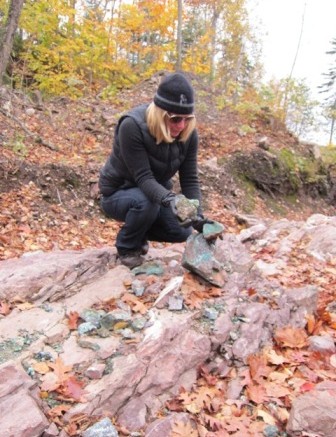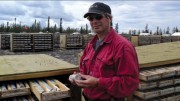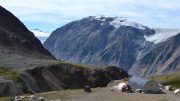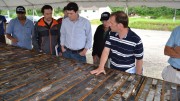SAULT STE. MARIE, ONT. — Superior Copper (SPC-V) is hoping to find a new mine beside an old one as it gears up for another round of drilling on its flagship Batchawana copper property.
Located 90 km north of Sault Ste Marie in the Batchawana Bay area near Lake Superior, the project hosts the past-producing Coppercorp copper-silver-gold mine and is 20 km from Teck Resources’ (TCK-T, TCK-N) old Tribag copper mine.
The junior’s president and CEO Judy Baker, who was instrumental in restructuring Superior, previously Cenit Corp., believes the underexplored property has a lot of potential, pointing out the original Coppercorp mine was never drilled past 150 metres depth.
“This is the best upside project you can get,” she told The Northern Miner on an October 2012 site visit, adding the project is “highly financeable.”
Another feature that makes the property intriguing is the geological setting. The Batchawana project is on the north eastern flank of the Mid-Continental Rift within the Keweenawan Group of Proterozoic Southern Province. The Mid-Continental Rift is the same structure that formed Lake Superior and the famous Keweenawan peninsula copper mining region in the U.S, which was home of the initial copper rush in the mid-1800s and was mined for more than 150 years, the 46-year-old mining executive says.
Baker has about 20 years of experience in the junior exploration sector. Equipped with a MBA and a geological engineering degree, Baker worked as a mining analyst before being employed by junior companies, where she applied her business acumen to run and refocus firms such as Canada Lithium (CLQ-T), formerly Black Pearl Minerals.
In early 2010, Baker began pro bono consulting for Cenit, then a shell company, and was shortly asked to head up the company in November of that year.
In June 2011, Cenit listed on the TSX Venture Exchange as a Tier-2 resource issuer after completing a change of business and raising $2.7-million in a non-brokered private placement to fund exploration activities at the Batchawana project and the company’s Rivière Doré project in Quebec. The firm was renamed Superior Copper in January 2012.
The Coppercorp mine
Coppercorp Ltd. ran its namesake mine as a 500-ton-per-day underground operation from 1965 to 1972; around the same time as the nearby Tribag mine. The operation was profitable until 1968, after which it started posting operating losses until it closed due to falling copper prices.
Over the years, Coppercorp delivered roughly 23 million lb. copper from 1 million tons averaging 1.16% copper, along with 200,000 oz. silver and 2,000 oz. gold.
“They were able to develop two mines in this area back in the late 1960s and early 1970s, with the price of gold and copper where it is now, we should be able to do something similar,” lead geological consultant at Superior Delio Tortosa says.
After the mine shut down, the mineral rights were reverted to the Crown and the project was withdrawn from exploration for 30 years as the tailings pond, unkempt mine shaft and some of the buildings on site were considered to be a liability, Baker explains.
After the mine area was rehabilitated most of the property was reopened for staking in 2002, bringing in several companies to explore and test the property, believed to have the right environment to potentially host iron oxide copper-gold deposits.
Amerigo Resources (ARG-T) and Nikos Explorations (NIK-V) were among the juniors interested in the Coppercorp property, now called the Batchawana project.
In 2003, Amerigo had an airborne magnetic survey flown over the property and discovered a large magnetic anomaly in the centre of the project.
A year later, Nikos acquired the Batchawana project and carried out two drill programs in 2005, with the best (uncut) intercept returning 35.5 metres of 1.63% copper and 5.15 grams silver per tonne.
Nikos’ president Roger Moss sits on Superior’s board of directors, along with Bruce Staines, who worked at the original Coppercorp mine.
In September 2010, Superior optioned to acquire 50% of the Batchawana property from First Minerals Exploration, a private entity, covering the Proterozoic Keweenawan Group, the Mid-Continental Rift unconformity and the western portion of the Batchawana greenstone belt.
Copper mineralization on the property consists mostly of chalcocite with minor malachite and chalcopyrite associated with pyrite and hematite, the company says, noting the mineralization is hosted in vein breccias and to a lesser extent in felsite dykes.
Superior, the operator of the joint-venture, completed its 50% earn-in in the Batchawana property in September 2012.
Let the drilling begin
In June 2011, the Toronto-based firm’s joint-venture partner signed a two-year exploration agreement with the Batchawana First Nations, allowing Superior to kick off a small two-phase drill program that ran from July 2011 to March 2012.
The first 20-hole phase tested the past-producing mine’s B zone at surface, the depth extension of the C zone, and the southeast extension, dubbed the SB zone. The second drill phase focused on the Kincaid breccia, 6 km to the northeast. This structure was never drilled before.
Of the 20 holes, 13 or 900 metres were completed in the B zone. While the results appeared promising, they failed to demonstrate continuity of the vein breccia at depth and along strike to the south. One 377-metre hole was then drilled in the C zone, intersecting the vein breccia structure 100 metres below the old mine’s level three workings.
Superior put the remaining six holes or 1,000 metres on the SB zone, where the drilling outlined the zone for a half kilometre along strike and cut an average of 3 metres of 3% copper, Baker explains, adding the best intercept carried 4.8 metres of 7.27% copper and 144.5 grams silver per tonne.
During the second drill phase, the firm drilled 12 holes in the Kincaid breccia, where one hole failed to returned significant mineralization. The drilling indicated continuity along the 300-metre tested strike length and at a depth of 50 metres, however, the copper grades varied from 0.32% to 3.70%.
Superior wrapped up the drill program in March 2012 and initiated a spring–summer field program, where it completed several ground geophysical surveys to collect magnetic, gravity and induced polarization data over the magnetic high anomaly to identify potential drill targets. Soil sampling and mapping were also used to pinpoint additional targets, Baker says, pointing out soil geochemistry was used to discover the past-producing Coppercorp mine.
To fund further exploration efforts, Superior recently raised $800,000 in a non-brokered private placement in December, where it sold 3.7 million hard-dollar units at 10¢ apiece and 3.5 million flow-through units at 12¢.
For 2013, Superior has planned an initial 2,000-metre winter program to follow up on the results from the SB and C zones. It will then test the Glenrock gold prospect adjacent to the Batchawana project in the spring, before drilling the 2 by 3 km magnetic anomaly in the summer.
Gle
nrock is one of the six acquisitions that the Toronto-based firm has made to date to lock up ground around the Batchawana property. The 25-sq.-km property is about 3 km from the Coppercorp mine and was explored in the early 1990s by Noranda Inc. The firm conducted two exploration trenches across the property and found gold grading 4.68 grams per tonne over 6 metres. Superior acquired 100% of the property from Hudson River Minerals (HRM-V) last June.
More recently, in December 2012, it bought a 50% interest in the 1.3 sq. km Jogran porphyry, where historic intercepts averaged 0.19% copper and 0.05% molybdenum disulfide. Other acquisitions include a 100% interest in the Palmer and Pall Mall projects and 50% of the Richard’s breccia property. (The six properties are not subjected to the joint-venture agreement with First Minerals.)
While the company is acquiring nearby prospects, Baker says the main focus is still the Batchawana project, where she believes at least another two years of drilling are required before determining whether the project is economically viable.
“My view is, if you have a good project — focus, focus, focus — and finance it for the next couple years,” Baker says.
Rivière Doré
Superior’s second asset is the 150 sq. km Rivière Doré project located 85 km
southeast of Val-D’Or, Que., inside the once-taboo Grenville front. The project is surrounded by Copper One’s (CUO-V) 600 sq. km Rivière Doré property, but Baker believes her company has the key ground in the area.
The Rivière Doré property has not been explored since Campbell Resources drilled it in the late 1960s, where one intercept returned 6.7 metres of 0.58% copper.
The property was largely overlooked for decades as it is in the Grenville Front, an area known to contain strong deformation and faulting, making it hard to find tonnage and as a result was often avoided by major miners.
“So if you were the vice-president of exploration of Xstrata or BHP Billiton, you weren’t allowed to carry out exploration in the Greenville Front because you couldn’t put tonnes together,” Baker says.
However an airborne magnetic survey flown by the Geological Survey of Canada in 2010 suggests the contrary. It indicated that Grenville front’s Bouchette anorthosite complex, known to provide the right host rock for copper-nickel-platinum group elements, is in late stage and largely intact.
During the same year, stream and lake sediment data compiled by the Quebec Ministry of Mines found anomalous copper and nickel values in streams from the Rivière Doré project. The values were ranked in the top-one percentile of results ever taken in the province, attracting Superior to acquire the Rivière Doré claims from a private company in 2011.
Baker believes the project requires two to five years of exploration before the junior can “pin the tail on the donkey,” and determine whether the mineralization is economic.
Copper One and the company are working with the local First Nations communities to reach an exploration agreement.
Superior Copper closed at 7.5¢ within a 52-week range of 4¢ to 10¢. It has a market capitalization of nearly $5 million.






Is this the IOCG that you were previously interested in? Bob